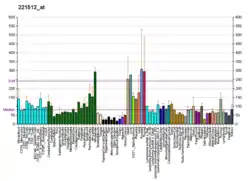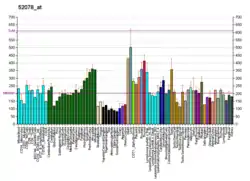Transmembrane protein 222
Transmembrane protein 222 is a protein that in humans is encoded by the TMEM222 gene.[5][6] One notable feature of the protein encoded by this gene is the presence of three predicted transmembrane domains.[7] The TMEM222 protein is predicted to most likely localize to the secretory vesicles.[8]
| TMEM222 | |||||||||||||||||||||||||
|---|---|---|---|---|---|---|---|---|---|---|---|---|---|---|---|---|---|---|---|---|---|---|---|---|---|
| Identifiers | |||||||||||||||||||||||||
| Aliases | TMEM222, C1orf160, transmembrane protein 222 | ||||||||||||||||||||||||
| External IDs | MGI: 1098568 HomoloGene: 11999 GeneCards: TMEM222 | ||||||||||||||||||||||||
| |||||||||||||||||||||||||
| |||||||||||||||||||||||||
| |||||||||||||||||||||||||
| Orthologs | |||||||||||||||||||||||||
| Species | Human | Mouse | |||||||||||||||||||||||
| Entrez | |||||||||||||||||||||||||
| Ensembl | |||||||||||||||||||||||||
| UniProt | |||||||||||||||||||||||||
| RefSeq (mRNA) | |||||||||||||||||||||||||
| RefSeq (protein) | |||||||||||||||||||||||||
| Location (UCSC) | Chr 1: 27.32 – 27.34 Mb | Chr 4: 133.27 – 133.28 Mb | |||||||||||||||||||||||
| PubMed search | [3] | [4] | |||||||||||||||||||||||
| Wikidata | |||||||||||||||||||||||||
| |||||||||||||||||||||||||
Gene Features
TMEM222 has a domain of unknown function (DUF778).[9] Aliases of this gene include DKFZP564D0478, RP11-4K3__A.4, C1orf160, and MGC111002.[10] Accession NM_032125.2, the longest coding sequence (1629 bp), encodes a protein of 208 amino acid residues (23230 Daltons), which is considered the consensus coding sequence (CCDS297.2).[11] There are two isoforms of the protein encoded by this gene. They are similar except the second (Q9H0R3-2) is lacking the first 96 amino acid residues that are present in the first (Q9H0R3-1).[12]
Gene Expression
ACEVIEW has labeled TMEM222 as highly expressed with 3.8 times more expression than the average gene in the database.[13] There is expression evidence from 166 tissues including brain, lung, colon, kidney, and placenta.[13]
Homology
Orthologs and distant homologs of the human TMEM222 have been identified throughout Eukaryota especially in plants and animals.[14] No paralogs of this gene have been found in the human genome.[15]
| Genus/Species | Common Name | Accession Number | Length | Similarity | Identity |
|---|---|---|---|---|---|
| Rattus norvegicus | Rat | NP_001107252.1 | 208aa | 99% | 96% |
| Canis familiaris | Dog | XP_852505.1 | 208aa | 98% | 96% |
| Mus musculus | Mouse | NP_079943.2 | 208aa | 96% | 95% |
| Sus scrofa | Pig | XP_003127773.1 | 208aa | 97% | 94% |
| Equus caballus | Horse | XP_001917747.1 | 207aa | 94% | 93% |
| Gallus gallus | Chicken | XP_417729.1 | 182aa | 90% | 85% |
| Danio rerio | Zebrafish | NP_001013334.1 | 174aa | 83% | 71% |
| Anopheles gambiae | Mosquito | XP_320483.3 | 197aa | 66% | 53% |
| Drosophila melanogaster | Fruit Fly | NP_723362.1 | 196aa | 74% | 61% |
| Caenorhabditis elegans | Nematode | NP_494762.2 | 168aa | 72% | 55% |
| Phytophthora infestans | Late Blight | XP_002902629.1 | 186aa | 59% | 48% |
| Zea mays | Corn | NP_001144071.1 | 233aa | 61% | 44% |
| Oryza sativa | Rice | NP_001051577.1 | 204aa | 61% | 43% |
| Arabidopsis thaliana | Thall cress | NP_190673.1 | 231aa | 55% | 36% |
| Homo sapiens | Human | NP_115501.2 | 208 | - | - |
Distant Homolog
A distant homolog of TMEM222,[14] RTH (RTE1-Homolog),[16] is a homolog of RTE1 (Reversion-to-Ethylene Perception 1), which is known to induce conformational changes in ETR1 (Ethylene receptor 1) that result in negative regulation corresponding with loss of ethylene perception.[17]
Protein Interactions
Evidence from yeast two-hybrid screening exists for two protein interactions with this gene. One is a serine protease (PRSS23)[18] that has been identified to be involved in mouse ovulation and is excreted into the extracellular matrix.[19] The other protein is an ab-hydrolase (HLA-B associated transcript 5)[20] that is integral to the membrane, and its corresponding gene is located in the genome near Tumor Necrosis Factor (TNF)-alpha and TNF-beta.[21]
References
- GRCh38: Ensembl release 89: ENSG00000186501 - Ensembl, May 2017
- GRCm38: Ensembl release 89: ENSMUSG00000028857 - Ensembl, May 2017
- "Human PubMed Reference:". National Center for Biotechnology Information, U.S. National Library of Medicine.
- "Mouse PubMed Reference:". National Center for Biotechnology Information, U.S. National Library of Medicine.
- Wiemann S, Weil B, Wellenreuther R, Gassenhuber J, Glassl S, Ansorge W, Bocher M, Blocker H, Bauersachs S, Blum H, Lauber J, Dusterhoft A, Beyer A, Kohrer K, Strack N, Mewes HW, Ottenwalder B, Obermaier B, Tampe J, Heubner D, Wambutt R, Korn B, Klein M, Poustka A (Mar 2001). "Toward a catalog of human genes and proteins: sequencing and analysis of 500 novel complete protein coding human cDNAs". Genome Res. 11 (3): 422–35. doi:10.1101/gr.GR1547R. PMC 311072. PMID 11230166.
- "Entrez Gene: C1orf160 chromosome 1 open reading frame 160".
- TMHMM
- k-NN
- NCBI (National Center for Biotechnology information)
- Gene Cards
- Uniprot
- Uniprot
- ACEVIEW
- Homologene
- BLAST
- "RTH RTE1-homolog [Arabidopsis thaliana (thale cress)] - Gene - NCBI".
- Resnick JS, Wen CK, Shockey JA, Chang C (May 2006). "REVERSION-TO-ETHYLENE SENSITIVITY1, a conserved gene that regulates ethylene receptor function in Arabidopsis". Proc. Natl. Acad. Sci. U.S.A. 103 (20): 7917–22. doi:10.1073/pnas.0602239103. PMC 1458508. PMID 16682642.
- Stelzl U, Worm U, Lalowski M, Haenig C, Brembeck FH, Goehler H, Stroedicke M, Zenkner M, Schoenherr A, Koeppen S, Timm J, Mintzlaff S, Abraham C, Bock N, Kietzmann S, Goedde A, Toksöz E, Droege A, Krobitsch S, Korn B, Birchmeier W, Lehrach H, Wanker EE (September 2005). "A human protein-protein interaction network: a resource for annotating the proteome". Cell. 122 (6): 957–68. doi:10.1016/j.cell.2005.08.029. hdl:11858/00-001M-0000-0010-8592-0. PMID 16169070.
- Miyakoshi K, Murphy MJ, Yeoman RR, Mitra S, Dubay CJ, Hennebold JD (December 2006). "The identification of novel ovarian proteases through the use of genomic and bioinformatic methodologies". Biol. Reprod. 75 (6): 823–35. doi:10.1095/biolreprod.106.052290. PMID 16870946.
- Lehner B, Semple JI, Brown SE, Counsell D, Campbell RD, Sanderson CM (January 2004). "Analysis of a high-throughput yeast two-hybrid system and its use to predict the function of intracellular proteins encoded within the human MHC class III region". Genomics. 83 (1): 153–67. doi:10.1016/S0888-7543(03)00235-0. PMID 14667819.
- Spies T, Bresnahan M, Strominger JL (November 1989). "Human major histocompatibility complex contains a minimum of 19 genes between the complement cluster and HLA-B". Proc. Natl. Acad. Sci. U.S.A. 86 (22): 8955–8. Bibcode:1989PNAS...86.8955S. doi:10.1073/pnas.86.22.8955. PMC 298409. PMID 2813433.
Further reading
- Maruyama K, Sugano S (1994). "Oligo-capping: a simple method to replace the cap structure of eukaryotic mRNAs with oligoribonucleotides". Gene. 138 (1–2): 171–4. doi:10.1016/0378-1119(94)90802-8. PMID 8125298.
- Suzuki Y, Yoshitomo-Nakagawa K, Maruyama K, et al. (1997). "Construction and characterization of a full length-enriched and a 5'-end-enriched cDNA library". Gene. 200 (1–2): 149–56. doi:10.1016/S0378-1119(97)00411-3. PMID 9373149.
- Strausberg RL, Feingold EA, Grouse LH, et al. (2003). "Generation and initial analysis of more than 15,000 full-length human and mouse cDNA sequences". Proc. Natl. Acad. Sci. U.S.A. 99 (26): 16899–903. Bibcode:2002PNAS...9916899M. doi:10.1073/pnas.242603899. PMC 139241. PMID 12477932.
- Lehner B, Semple JI, Brown SE, et al. (2004). "Analysis of a high-throughput yeast two-hybrid system and its use to predict the function of intracellular proteins encoded within the human MHC class III region". Genomics. 83 (1): 153–67. doi:10.1016/S0888-7543(03)00235-0. PMID 14667819.
- Ota T, Suzuki Y, Nishikawa T, et al. (2004). "Complete sequencing and characterization of 21,243 full-length human cDNAs". Nat. Genet. 36 (1): 40–5. doi:10.1038/ng1285. PMID 14702039.
- Gerhard DS, Wagner L, Feingold EA, et al. (2004). "The status, quality, and expansion of the NIH full-length cDNA project: the Mammalian Gene Collection (MGC)". Genome Res. 14 (10B): 2121–7. doi:10.1101/gr.2596504. PMC 528928. PMID 15489334.
- Rual JF, Venkatesan K, Hao T, et al. (2005). "Towards a proteome-scale map of the human protein-protein interaction network". Nature. 437 (7062): 1173–8. Bibcode:2005Natur.437.1173R. doi:10.1038/nature04209. PMID 16189514.
- Gregory SG, Barlow KF, McLay KE, et al. (2006). "The DNA sequence and biological annotation of human chromosome 1". Nature. 441 (7091): 315–21. Bibcode:2006Natur.441..315G. doi:10.1038/nature04727. PMID 16710414.





